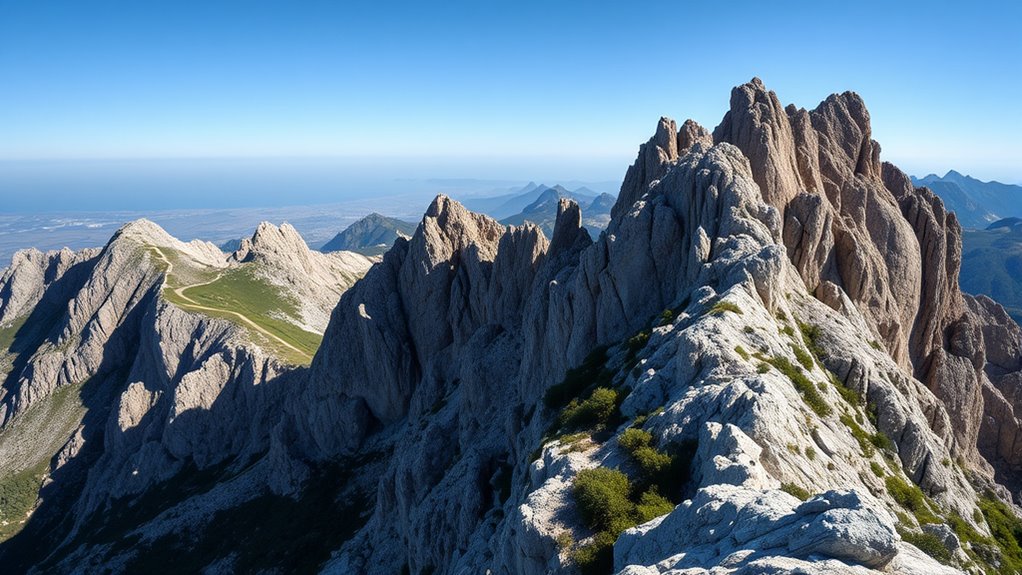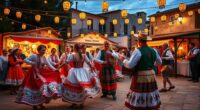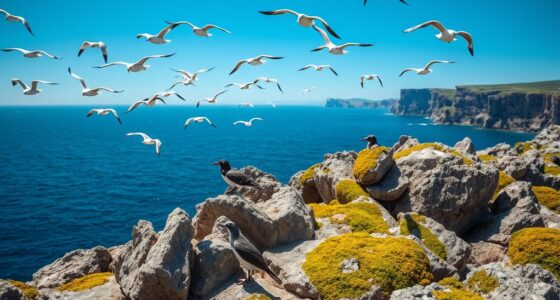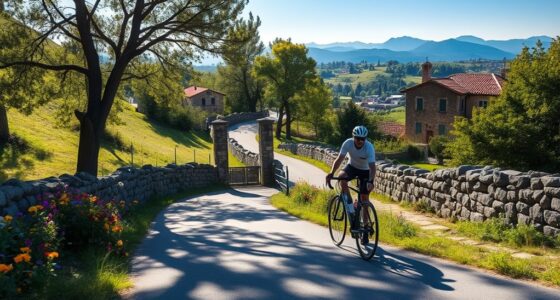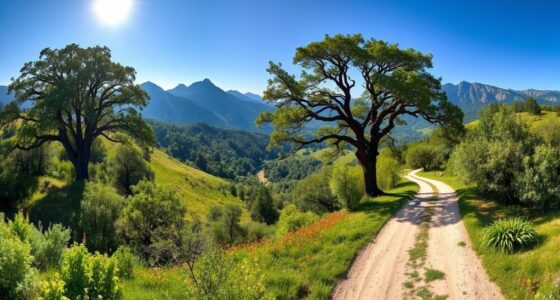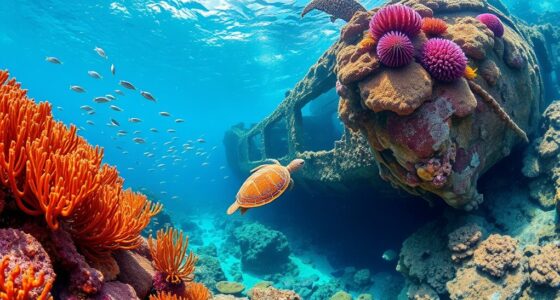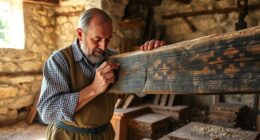Sardinia’s mountaineering offers stunning peaks like the Gennargentu Range and Punta La Marmora, the island’s highest point. You can explore rugged limestone cliffs on the north and west faces, or tackle challenging routes on Monte Maccione. The landscape features forests, gorges, and coastal cliffs, with routes for all skill levels. With unique flora and fauna thriving in mountain environments, there’s plenty to discover. Keep going to uncover more about Sardinia’s incredible alpine and coastal adventures.
Key Takeaways
- Gennargentu Massif is Sardinia’s highest range, offering peaks like Punta La Marmora and diverse hiking and climbing routes.
- Climbing routes range from moderate hikes to demanding multi-pitch climbs, including notable sites like Monte Maccione and Hotel Supramonte.
- Access points such as Cala Gonone, Domusnovas, and Baunei provide extensive routes and climbing infrastructure for all skill levels.
- The Supramonte Plateau features scenic trekking, rock climbing, and archaeological sites amid rugged limestone landscapes.
- Sardinian weather, including Scirocco winds, allows year-round mountaineering with proper safety precautions.
The Gennargentu Massif: Sardinia’s Mountain Heart
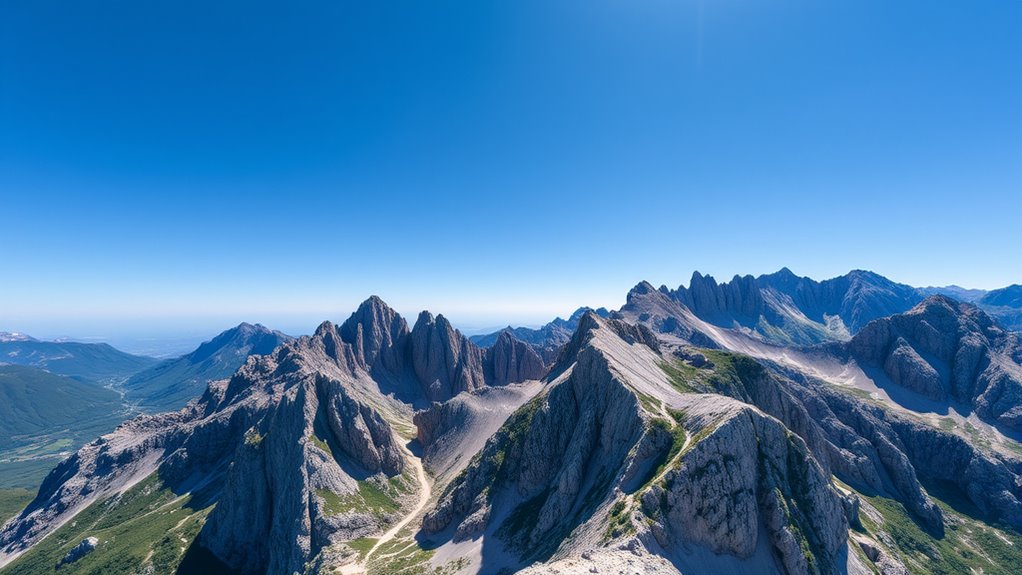
Nestled in the heart of Sardinia, the Gennargentu Massif stands as the island’s highest and most prominent mountain range. Located mainly in Nuoro province within the Barbagia area, it forms the core of Gennargentu National Park. The landscape features steep slopes, deep valleys, and lush forests, including alder woods and alpine meadows. You’ll find villages like Desulo and Arzana nearby, which reflect traditional Sardinian life. From the peaks, on clear days, you can enjoy panoramic views of the coastlines and distant mountain summits. The region hosts rare habitats, supporting wildlife such as mouflons and golden eagles. Its diverse ecosystems and ancient sheepfolds reveal a rich cultural and ecological heritage, making Gennargentu a essential part of Sardinia’s natural and historical identity. The Gennargentu range is also popular for hiking and mountaineering, attracting outdoor enthusiasts from around the world. Understanding the geological features of the range can enhance your appreciation of its rugged beauty and ecological significance.
Punta La Marmora: Sardinia’s Highest Pinnacle
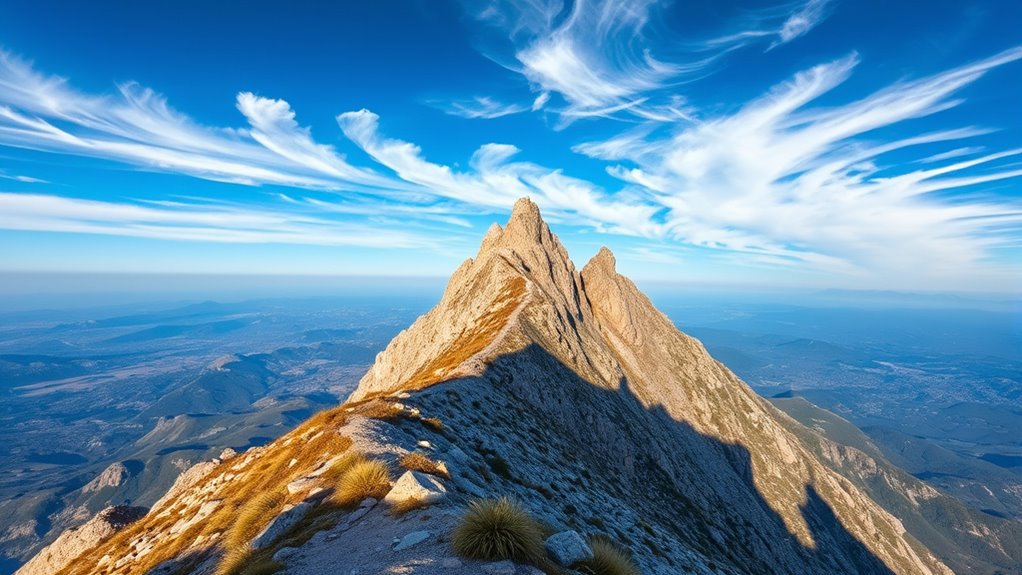
Have you ever wondered what Sardinia’s highest point looks like? Punta La Marmora reaches 1,834 meters in the Gennargentu range, perched in the rugged heart of the island. Located in Nuoro’s Barbagia region, it offers panoramic vistas on clear days, stretching across Sardinia and even toward Corsica. Its Paleozoic shales form a dramatic, rocky summit, often blanketed in snow during winter, with winds that can reach 100 km/h. The most common route starts from Bruncu Spina, accessible via a ski lift and a well-marked trail, making it a favorite for hikers. Named after naturalist Alberto Ferrero della Marmora, it stands as a key symbol of Sardinian mountaineering, drawing eco-tourists and adventure seekers alike to conquer its impressive heights. Situated in Nuoro’s Barbagia region, it is also part of the mountain range that forms the inner Sardinian landscape.
Exploring the Supramonte Plateau and Costiera

After reaching Sardinia’s highest summit at Punta La Marmora, your attention can shift to exploring the rugged beauty of the Supramonte Plateau and the scenic Costiera coastline. On the Supramonte crossing, you’ll trek 50 km over four days, passing springs, Nuragic ruins, and the Su Sercone chasm. Traditional refuges host you each night. Rock climbing near Oliena, Urzulei, and Cala Gonone offers sport routes on limestone, from slabs to overhangs, with bolted protection. For experienced climbers, big walls like Punta Giradili provide multi-pitch adventures. The region’s deep gorges, fossils, and archaeological sites highlight its natural and cultural richness. Meanwhile, the Costiera coastline features sea cliffs with challenging single and multi-pitch climbs, attracting climbers seeking scenic, adrenaline-fueled routes.
| Location | Climbing Style | Key Features |
|---|---|---|
| Supramonte | Trekking & Rock Climbing | Nuragic sites & deep gorges |
| Oliena/Urzulei | Sport Climbing | Limestone sectors, slabs, overhangs |
| Cala Gonone | Sea Cliff Climbing | Ocean views, diverse routes |
| Punta Giradili | Multi-Pitch Climbing | Vertical limestone spire |
Climbing Routes on Gennargentu’s North and West Faces
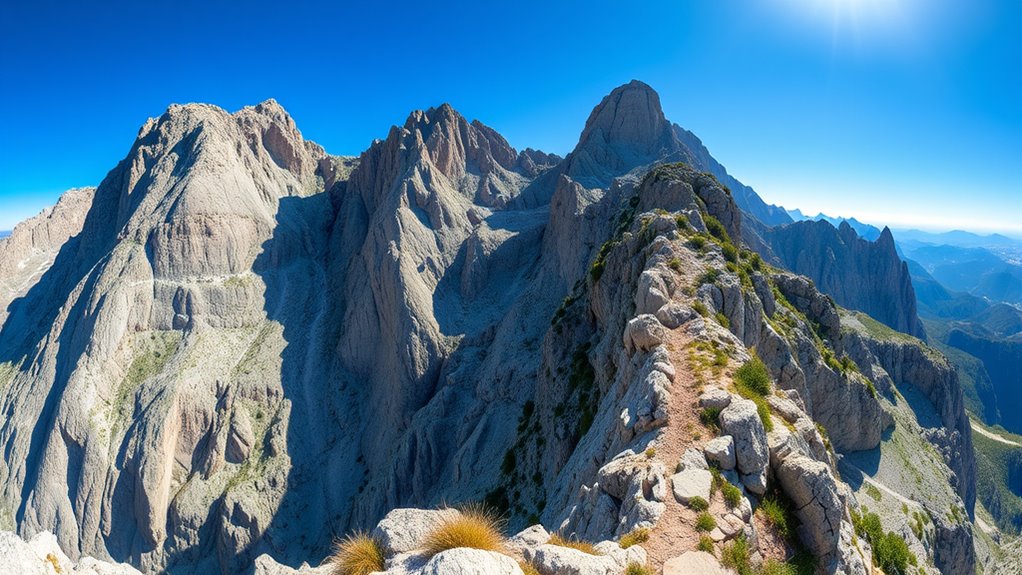
The north and west faces of Gennargentu challenge climbers with their steep, vertical limestone cliffs. You’ll find routes that demand advanced skills, from technical multi-pitch climbs to exposed sections that test your confidence. Whether you’re after demanding overhangs or technical slabs, these faces offer a wide spectrum of difficulty for dedicated climbers. Notably, these areas are characterized by their limestone rock, which provides unique technical challenges and requires precise movement and placement of gear. The rock quality in these faces is generally excellent but can vary, demanding climbers stay attentive.
Vertical Rock Challenges
Are you ready to face the vertical challenges of Gennargentu’s north and west faces? These cliffs feature sharp limestone with overhangs, demanding technical skill and careful protection placement. Routes start from high ledges accessible only by abseil, with no ground-up options and limited retreat options. Expect sustained exposure, fragile pockets, and varied textures from reddish limestone to Verdonesque slabs. The north face offers multi-pitch, sport climbing with vertical, overhanging sections that require advanced technique. The west face presents technical slabs that are lightly overhung and sustained, providing a different style of challenge. Both faces are accessed by abseil, necessitating ropes up to 75 meters, and the environment offers scenic views of coastal bays and high-altitude wilderness. These routes are renowned for their unique geological features, making them a premier destination for experienced climbers seeking technical excellence and breathtaking scenery. Additionally, understanding the mountaineering environment can greatly enhance safety and planning for such demanding ascents.
Route Difficulty Spectrum
Gennargentu’s north and west faces offer a wide range of climbing experiences, from accessible hikes to formidable technical routes. You’ll find routes spanning from moderate trails to demanding climbs graded 6c to 8b+. Long treks, like the S’Arena – Arcu Gennargentu trail, require good physical condition but are suitable for non-expert hikers and highlight scenic landmarks. Technical routes, such as “Hotel Supramonte” (8a+), demand specialized gear, endurance, and skill, often involving multi-pitch climbs up to 15 pitches. The terrain features rugged outcrops, old ski slopes, and alpine passes, adding to the challenge. Whether you seek a scenic hike or a technical ascent, the route difficulty spectrum on these faces caters to all levels, emphasizing preparation, skill, and respect for the environment. Additionally, the diverse landscape includes ancient forests and scenic valleys, providing breathtaking scenery and a variety of climbing environments that attract adventurers from around the world. For climbers, understanding the route difficulty spectrum and local conditions can significantly enhance safety and enjoyment.
Monte Maccione: A Climber’s Haven
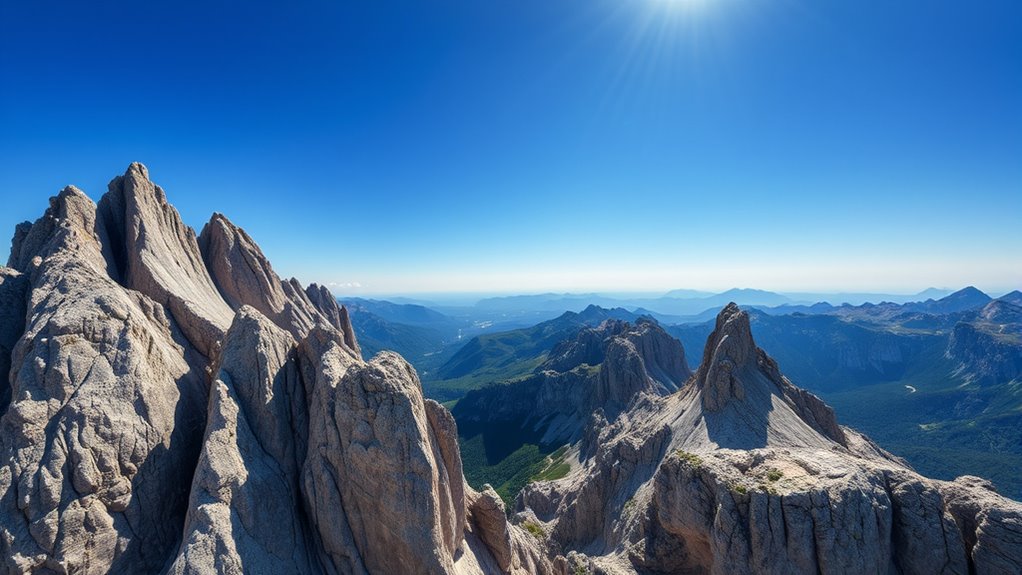
Nestled near Oliena in Sardinia’s Nuoro region, Monte Maccione stands out as a premier destination for climbers seeking challenging vertical walls and diverse routes. Its 2.3-kilometer ascent with a 257-meter vertical gain offers moderate slopes and superb rock quality. The vertical rock faces are ideal for sport climbing, with routes graded from 6a to 7c, including historic lines like “Assiri” at 8a. Bolted with modern hardware, these routes are accessible and safe. The area’s sheltered location from Scirocco winds allows year-round climbing, especially in winter months like January. Approaching is straightforward—about 20 minutes from the base—making it perfect for day trips. Monte Maccione attracts a vibrant climbing community, serving as both a training ground and a challenge for intermediate and advanced climbers. Recognized as one of the most popular climbing destinations in Sardinia, it draws enthusiasts from across Europe. Additionally, the impact of natural environment on climbing conditions ensures optimal safety and enjoyment for visitors.
Flora and Fauna of Sardinian Mountain Environments

As you explore Sardinian mountains, you’ll notice many high-altitude species specially adapted to thrive in rugged conditions. Vegetation like fragrant mountain roses and ancient junipers flourishes in microclimates, while animals such as mouflons and Sardinian wild cats navigate rocky terrains. These unique flora and fauna showcase nature’s resilience at elevated elevations. The Sardinian wildcat is a critically endangered species that inhabits some of these mountainous regions, emphasizing the importance of conservation efforts. Additionally, the presence of endemic species highlights Sardinia’s unique ecological heritage.
Unique High-Altitude Species
| Flora | Fauna |
|---|---|
| *Castroviejoa* | Reptiles adapted to rocky slopes |
| *Lamyropsis microcephala* | Birds co-evolving with endemic plants |
| Sardinian junipers | Insects specialized for mountain habitats |
| Mountain meadows species | Small mammals unique to highlands |
| The mountainous regions host a variety of endemic plant species, which have evolved unique adaptations to survive in high-altitude conditions. Additionally, the high-altitude ecosystems support a range of specialized organisms found nowhere else.
Vegetation Adaptations to Elevation
Vegetation in Sardinian mountain environments has evolved remarkable adaptations to cope with the challenges posed by increasing elevation. As you ascend, you’ll notice distinct zones: Mediterranean scrub and oak forests at lower levels give way to mixed temperate forests higher up. Temperature drops and moisture availability shift with elevation, shaping plant communities and undergrowth diversity. Holm oak dominates the lower slopes, while downy oak and species like Fraxinus ornus and Ostrya carpinifolia thrive at mid-elevations. Plants develop xerophytic features—tough, leathery leaves, deep roots, and protective cuticles—to withstand drought, wind, and UV stress. Many species also display phenotypic plasticity, adapting rapidly to microclimate changes. Sardinia’s mountain flora has also been influenced by its geological history, which has led to the presence of unique endemic species. The geological history has contributed to a diversity of endemic plants, making Sardinian mountain flora particularly distinctive. Faunal interactions, from grazing to seed dispersal, further influence vegetation patterns along these elevation gradients.
Access Points and Base Villages for Mountaineers
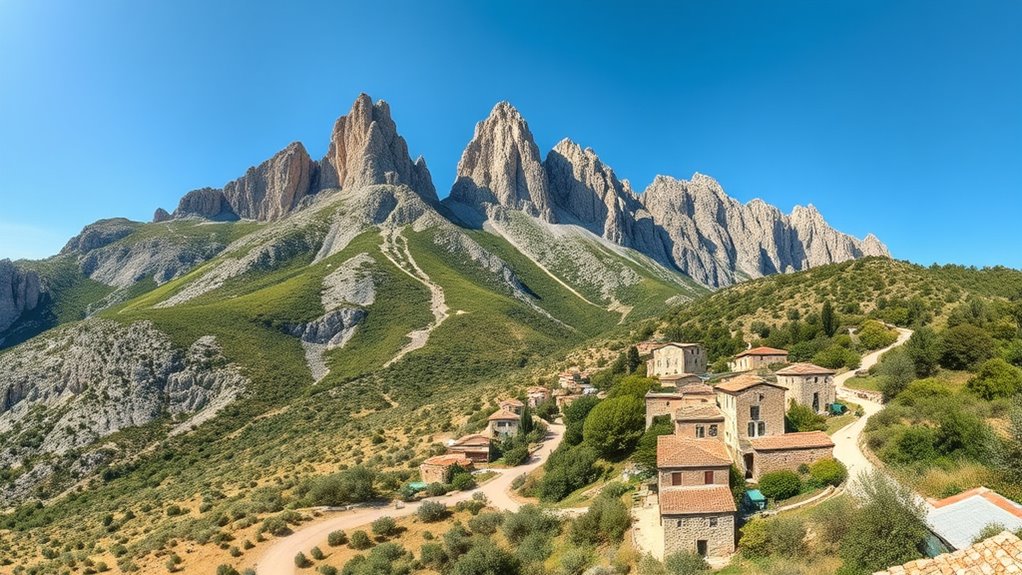
Sardinian mountaineering enthusiasts find their base points and access villages essential for exploring the island’s diverse climbing terrain. Cala Gonone on the east coast offers over 900 routes and serves as a hub for all skill levels, with nearby climbing schools. Domusnovas in the south provides 600+ routes, ideal for all climbers, close to Cagliari. Baunei/Ogliastra, accessible via mountain roads, is key for multi-pitch routes like Goloritzè. Coastal villages like Santa Maria Navarrese and Orosei give climbers scenic access points, while Dorgali connects to Supramonte’s cliffs. In the south, Jerzu and Ulassai support beginners and experts with roughly 1,000 routes. These villages form the backbone for your Sardinian climbing adventures. Additionally, many of these access points are situated near mountain roads, facilitating easier transportation to the climbing sites.

Traversing Sardinia’s diverse terrain requires careful planning and awareness of the island’s unique geological features. Weather can change rapidly, especially with strong winds like the mistral and scirocco, which impact safety and comfort. Avoid climbs during high winds; a clear horizon over the sea indicates good conditions, while foggy views suggest humidity and potential slipperiness. Sardinia’s main ranges—Gennargentu, Supramonte, and granite zones—demand specific tactics. Limestone walls can be polished and slippery when humid, so check rock conditions before committing. Inspect bolts regularly, as coastal corrosion is common. For multi-pitch routes, carry extra gear and plan for exposure and length. Match route difficulty to your skill level, and stay informed about recent weather and route conditions to make certain of a safe and successful climb. Knowing the local weather patterns and rock types is essential for a safe mountaineering experience on the island. Additionally, understanding remote hackathons can provide opportunities for virtual training and collaboration with other climbers and enthusiasts worldwide.
Frequently Asked Questions
What Permits Are Required for Technical Climbs in Sardinian Peaks?
You might wonder what permits you need for technical climbs in Sardinian peaks. Usually, no official permits are required for general technical routes, but restrictions can apply in protected areas or parks. If you’re guided by certified professionals, they handle permissions for you. Always check with local authorities or guides beforehand to make certain you’re compliant, especially in sensitive zones, and respect environmental regulations to avoid issues.
Are Guided Mountaineering Tours Available on Sardinian Mountains?
Yes, guided mountaineering tours are available on Sardinian mountains. You can hire Italian-certified guides who offer tailored experiences like multipitch climbs, via ferratas, and trekking adventures. These tours are suitable for all skill levels, often including equipment, safety measures, and additional support such as accommodations. Whether you want coastal climbs or interior treks, guides guarantee a safe, memorable outdoor experience across Sardinia’s stunning peaks and terrains.
What Is the Best Season for High-Altitude Mountaineering in Sardinia?
The best season for high-altitude mountaineering in Sardinia is from April to October. During this period, the weather is warmer, and days are longer, giving you more time to enjoy your climbs. Spring and early autumn are ideal, offering stable conditions and moderate temperatures. Summer can be hot, so plan your ascent early in the day or seek shaded routes. Avoid winter, as conditions tend to be wet and cooler, limiting high-altitude options.
How Challenging Are the Hiking Routes to Punta La Marmora?
The hiking routes to Punta La Marmora are relatively moderate, perfect if you have some hiking experience. You’ll encounter well-marked, wide trails with gentle to moderate inclines, making it accessible for most fit hikers. The terrain varies from forested streams to rocky summits, but no technical skills are necessary. Just prepare for a long walk, carry enough water, and watch weather conditions, especially near the exposed rocky sections.
Are There Emergency Rescue Services Specifically for Mountain Climbers in Sardinia?
Like a safety net beneath a tightrope walker, Sardinia’s emergency rescue services keep climbers secure. You can rely on CNSAS, which responds 24/7 with trained volunteers and professionals, using ground crews and helicopters to reach remote areas swiftly. Whether you’re injured or lost, these services prioritize quick, coordinated rescue operations, ensuring your safety in rugged terrains and hazardous routes across the island.
Conclusion
Ready to conquer Sardinia’s peaks? With over 1,500 kilometers of mountain trails and the Gennargentu Massif towering at 1,834 meters, this island offers endless adventure. Whether you’re tackling Punta La Marmora or exploring the Supramonte Plateau, you’ll discover breathtaking views and unique wildlife. So gear up and embrace the challenge—Sardinia’s mountains await your ascent, promising unforgettable experiences on every summit you reach.
